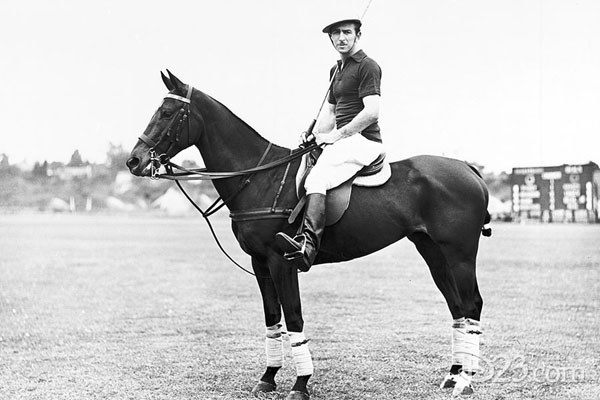
Suspended Animation #401
In the 1930s, polo was a very popular sport, especially among the entertainment industry even though it is an unbelievably intense physical sport.
This was a time when actors tried to emulate off-screen the macho characters they portrayed on the silver screen. While some of them were athletic, most of them were ill prepared for the demands of the difficult and challenging game of polo.
Polo was also used for social networking in the Hollywood community. The famous Beverly Hills Polo Lounge was created at this time and remains a Hollywood social gathering location today.
In the 1930s, there were more than 25 polo fields in Los Angeles, and the “Mickey Mouse Team” captained by Walt Disney played at the Uplifters Polo Field (now bulldozed and replaced with a street) and the Riviera Polo Field (now the home of the Paul Revere High School).
The Riviera adjoined a golf course and there were three or four polo fields and many celebrities kept stables there including Walt who had seven ponies. In the beginning, Walt enlisted Disney Studio personnel, including Jack Cutting, Norm Ferguson, Les Clark, Dick Lundy, Gunther Lessing, Bill Cottrell, and even his brother Roy to participate on his team.
In Hollywood, the strongest champion of the sport was humorist Will Rogers, who was introduced to the game in 1915. During the 1920s and 1930s, Rogers popularized the sport among the elite in Hollywood, from Hal Roach to Darryl Zanuck to Walt Disney.
Walt had a personal friendship with Rogers. In fact, at one time, he was negotiating with Rogers to appear in Walt’s first full-length animated feature film.
Snow White was not the first choice of a feature project for Walt. He had developed several possibilities including Alice in Wonderland featuring a live-action Mary Pickford as Alice interacting with animated characters.
When that project fell apart, Walt considered using the same basic concept but with Will Rogers as Rip Van Winkle interacting with animated characters. Rogers’ untimely death in 1935 put an end to that project.
Previously, Walt had sent some of his top Disney animators including Grim Natwick, Art Babbitt and Bill Tytla to Rogers’ Santa Monica ranch to sketch him in action and a caricature of Rogers appears in Mickey’s Gala Premier (1933) roping Mickey.
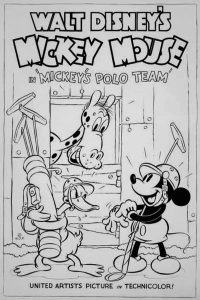 Mickey’s Polo Team was released on Jan. 4, 1936 and was directed by Dave Hand, whose attention was already focused on his directing responsibilities for Snow White.
Mickey’s Polo Team was released on Jan. 4, 1936 and was directed by Dave Hand, whose attention was already focused on his directing responsibilities for Snow White.
There isn’t much of a storyline in the cartoon. It is just an interesting premise for a series of physical gags of a polo game between four popular Disney animated characters against a team of four Hollywood celebrities.
The spectators in the stands are a mix of Disney animated characters and Hollywood celebrities (Clarabelle Cow kisses Clark Gable; Edna May Oliver sits next to Max Hare; Shirley Temple cheers next to the Three Little Pigs, etc.)
The Mickey Mouse team consists of Mickey, Donald Duck, Goofy and the Big Bad Wolf. The Hollywood team is composed of Charlie Chaplin, Oliver Hardy, Stan Laurel and Harpo Marx.
While modern audiences may struggle to identify the caricatures of some of the then-famous stars like Eddie Cantor, W.C. Fields, Harold Lloyd, even the most astute viewer of classic films on Turner Classic Movies might have trouble identifying the referee.
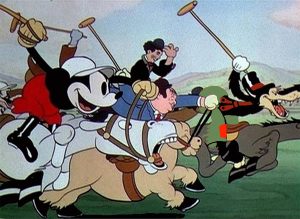 The referee is a caricature of Jack Holt, who was a popular silent screen star who made the transition to talkies primarily in Westerns. In fact, Holt was the father of famous Western movie cowboy star, Tim Holt.
The referee is a caricature of Jack Holt, who was a popular silent screen star who made the transition to talkies primarily in Westerns. In fact, Holt was the father of famous Western movie cowboy star, Tim Holt.
Jack Holt was a “manly man” and a strong supporter of polo as terrific physical exercise. He played at the Riviera alongside Walt Disney but is unfortunately forgotten by modern audiences.
This cartoon was made at the height of the Disney Studio’s involvement in playing polo. However, this was not the version that Walt originally intended. There was to be considerable footage devoted to a caricature of Will Rogers but his death during production of the short resulted in his caricature being removed from the cartoon.
The cartoon generated its own little controversy that has been forgotten over the years. The January 11, 1938 edition of the San Francisco Examiner ran a photo of Walt in Los Angeles looking pensive as he flipped through some papers. The caption stated:
Disney Faces Accuser in Court
Walt Disney, creator of the famous Mickey Mouse, shown during his appearance in court to answer charges of John P. Wade, writer and actor, that his animated cartoon, ‘Mickey’s Polo Club’ (sic), was taken from a scenario submitted by Wade. ‘Mr. Disney told me the script could not be used. Then, several months later, I saw the film,’ Wade testified. Disney contends the idea was his own.
This was the type of nuisance suit that has plagued Disney animated projects for decades. Time magazine for Jan. 24, 1938 revealed the outcome of this particular court action:
“When actor-author John P. Wade saw the Walt Disney cartoon, ‘Mickey’s Polo Team,’ he sued Disney for a share of the film’s profits. Alleged plagiarism that the gag of the horses riding the riders had been lifted from author Wade’s skit: ‘The Trainer’s Nightmare.’
Although it probably never popped up during the trial, in the January 1934 issue of Radio Stars magazine is a photo of Walt in his full polo outfit riding on a cartoon drawing of a running Mickey Mouse with the caption: “He rode to glory on a mouse.”“In court, attorneys for Cartoonist Walt Disney identified the device as a variation on ‘the reversal gag’ easily traced it to Aesop. Said Superior Court Judge Thomas C. Gould, dismissing the suit and plagiarizing Ecclesiastes: ‘…it appears there is nothing new under the sun’.”
By 1938, Roy Disney was becoming worried that the combination of Walt’s aggressiveness on the field and the inherent danger of the sport itself might rob the Disney Studio of its visionary leader. Roy quit the sport and sold off his horses.
That same year Walt took to the field. One of the players hit the ball just as Walt, who was on his horse, was turning around and the ball hit Walt hard enough to knock him from the saddle.
Walt had four of his cervical vertebrae crushed and was in tremendous pain. Instead of seeing a doctor, he went to a chiropractor, who manipulated Walt’s back. Sadly, the injury might have healed if Walt had been placed in a cast. Instead, it resulted in a calcium deposit building up in the back of his neck that resulted in a painful form of arthritis that plagued Walt for the rest of his life.
In his later years, Walt required a couple of shots of scotch and a massage from the studio nurse Hazel George in order to get home at night. When the back pain flared up, Walt was often unpleasant in his interactions with his staff. When he went into St. Joseph’s Hospital for the final time in 1966, it arose no suspicion when employees were told Walt was taking care of an “old polo injury.”


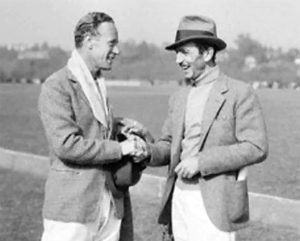
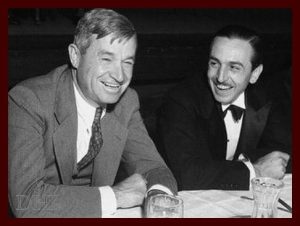
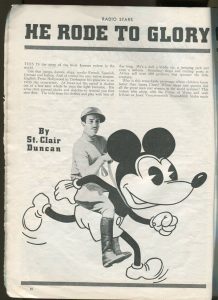
 Jim Korkis is an internationally respected animation historian who in recent years has devoted his attention to the many worlds of Disney. He was a columnist for a variety of animation magazines. With his former writing partner, John Cawley, he authored several animation related books including The Encyclopedia of Cartoon Superstars, How to Create Animation, Cartoon Confidential and Get Animated’s Animation Art Buyer’s Guide. He taught animation classes at the Disney Institute in Florida as well as instructing classes on acting and animation history for Disney Feature Animation: Florida.
Jim Korkis is an internationally respected animation historian who in recent years has devoted his attention to the many worlds of Disney. He was a columnist for a variety of animation magazines. With his former writing partner, John Cawley, he authored several animation related books including The Encyclopedia of Cartoon Superstars, How to Create Animation, Cartoon Confidential and Get Animated’s Animation Art Buyer’s Guide. He taught animation classes at the Disney Institute in Florida as well as instructing classes on acting and animation history for Disney Feature Animation: Florida.




















































The Hollywood polo-playing community probably thought their exploits would raise the spirits of a country beleaguered by the Great Depression. Upton Sinclair, during his 1934 run for governor, might have taken a different view. As he wrote of the Southern California elite in one of his novels: “They talked about their play, just as solemnly as if it had been work: tennis tournaments, golf tournaments, polo matches — all sorts of complicated ways of hitting a little ball about a field!”
A year before Disney released “Mickey’s Polo Match”, the Ub Iwerks ComiColor cartoon “Summertime” featured a polo match played by centaurs, one of them a gum-chewing caricature of Will Rogers. But Paul Terry beat both of them to the punch with the silent Aesop’s Film Fable “Polo Match”, played by his trademark identical mice on gasoline-powered mechanical horses. Van Beuren later re-issued it with a soundtrack as “Happy Polo” in 1932.
You mentioned in another column that over at Warner Bros., the McKimson brothers were enthusiastic polo players. Bob Clampett recalled that Tom and Bob showed up for their first day at Termite Terrace in full polo regalia, having played an early-morning match on their way to work.
It is a testimony to the timeless popularity of those personalities on the Hollywood team that they are still recognizable today. As for Jack Holt, anyone familiar with the classic semi-musical, semi-disaster film “San Francisco” will recognize him as the chief rival for Gable over the affections of Jeanette MacDonald.
it’s interesting that the cartoon shows Harpo riding an ostrich, something the real Harpo did three years later in “At the Circus.” I wonder if the screenwriter was inspired by the cartoon?
Holt’s 1941 serial “Holt of the Secret Service” is fun stuff. Holt’s a government agent who goes undercover to infiltrate a gang. This requires him to snarl and slap mugs around to convince them he’s not a good guy. He’s impressive tough for a man with an adult son and daughter (both starring in westerns, by the way). Maybe he’s genuinely angry, since Columbia put him in a serial as punishment and gave the character his real name to rub it in.
Last time I was at Disneyland a few years back, “Mickey’s Polo Game” was one of the Mickey cartoons running in the Main Street Cinema. It was in black and white to match the B&W Mickeys on the other screens.
All the movie moguls were into polo. “Mickey’s Polo Game,” ironically, is the beginning of Mickey’s downfall. He’s just kind of there (and that not very much) while Donald and Goofy and the movie star caricatures are getting the laughs.
The Goof doesn’t do much in this cartoon either.
Did the celebrities back then enjoy seeing themselves caricatured in animation or were they miffed? (Like some of them are when South Park does it?). I’m guessing it was a more good natured fun back then.
With a few rare exceptions, the celebrities were flattered if they were caricatured in the cartoons. It was the same as if Hirschfeld caricatured them in the New York Times. I suppose you could say, it was an honor!
Holt’s daughter Jennifer was also an actor, appearing in numerous B-westerns in the 1940s, often apposite Johnny Mack Brown. She could ride and shoot (and sing) with the best of ’em.
Cartoonist Al Capp created “Fearless Fosdick” as a satire of Chester Gould’s DICK TRACY in the 1940s. He appeared often in the famed LIL’ ABNER newspaper comic strip. Capp wasn’t just teasing his colleague Chester Gould, but if you look at the character closely, you’ll notice that Capp was also parodying actor Jack Holt. Holt’s no-nonsense tough guy – usually heroic – was extremely popular in the late 1920s and well into the ’30s – usually for Columbia Pictures.
HOLT OF THE SECRET SERVICE (1941) is a real parody of Jack Holt’s earlier screen persona. I’d like to know more about the history of this serial. If it was punishment for Holt to appear in this serial, he must have done something pretty bad to get Harry Cohn – or somebody at Columbia – to make him appear in the production. On the other hand, if the actor realized his “day in the sun” had passed and had done this for fun – you gotta give him credit for that. The serial is a lot of fun to watch!
I’ve heard that Bing Crosby was upset over one caricature of him in a Warner Bros. cartoon – I think – and I’ve heard that Rudy Vallee was teased over the caricature of him in Fleischer’s POOR CINDERELLA, but I’ve never heard that he was upset about it. He would later appear in a Paramount short with a live-action “Betty Boop.” (I can’t think of the name of it right now, but I’m sure a lot of you know it!)
Oliver Hardy’s widow Lucille told an audience in 1978 at a SONS OF THE DESERT convention in Chicago, that Stan Laurel was hoping that they could get a cartoon series based on LAUREL AND HARDY to be produced at Disney’s. Sadly, this did not happen – although the Larry Harmon – Hanna-Barbera series wasn’t as bad as it could have been!
The live-action short “Musical Justice” (1931), starring Mae Questel as Betty Boop with Rudy Vallee and his Connecticut Yankees, came out nearly three years before “Poor Cinderella”.
I doubt that Greta Garbo was flattered by all the cartoons that showed her with enormous feet. Garbo habitually wore slippers on the set because they were comfortable, and only bothered to change into shoes when her feet were in the shot. This habit, coupled with the vindictive nature of Hollywood gossip, gave rise to the rumours that her pedal extremities were colossal (to paraphrase Fats Waller).